A LES-ALM Study for the Turbulence Characteristics of Wind Turbine Wake Under Different Roughness Lengths
Abstract
1. Introduction
1.1. Research Background
1.2. Literature Review
1.3. Contributions of Paper
2. Numerical Simulation Method
2.1. LES Framework
2.2. ALM Framework
2.3. Domain Size and Mesh Distribution of Numerical Simulation
2.4. Numerical Parameters and Boundary Conditions of Simulation
3. Validation of Numerical Simulation Method
3.1. Independence Verification of Time Step
3.2. Validation of LES-ALM
4. Numerical Results of LES-ALM
4.1. ABL Wind Field
4.2. Mean Thrust and Power of Wind Rotor
4.3. Mean Velocity Deficit
4.4. Turbulence Intensity
4.5. Reynolds Shear Stress
5. Conclusions
- (1)
- Larger time step can be used for the numerical simulation of LES-ALM. As the time step increases, the thrust and power slightly decrease. However, the effects on the turbulent characteristics of the wake are not significant.
- (2)
- As roughness length increases, the fluctuations in thrust and power become more intense. Under the same hub-height wind speed, the turbine has the highest thrust coefficient of 0.82 when the roughness length is 0.005 m which is notably higher than the other two cases. Therefore, when analyzing the impacts of roughness length on the wake, the effects on the thrust coefficient should be considered.
- (3)
- The greater the roughness length, the more intense the environmental turbulence, leading to the faster recovery of velocity deficit and ATI within the wake. For the velocity deficit, a single Gaussian function is not able to describe its vertical distribution. Additionally, numerical simulation results reveal that when the roughness length is 0.5 m, the height of the wake center is significantly higher than the hub height. Thus, in future analytical models, the variation in the wake center with height should be considered to ensure the accuracy of model predictions.
- (4)
- Numerical simulations show that as roughness length increases, the Reynolds shear stress in the wake also increases, but the differences are not significant. Due to wind shear effects, the recovery of the added Reynolds shear stress component below the hub height is faster than above the hub height.
Author Contributions
Funding
Institutional Review Board Statement
Informed Consent Statement
Data Availability Statement
Acknowledgments
Conflicts of Interest
Abbreviations
| ABL | Atmospheric boundary layer |
| RANS | Reynolds-averaged Navier–Stokes |
| ALM | Actuator line method |
| LES | Large eddy simulation |
| ATI | Added turbulence intensity |
| TSR | Tip speed ratio |
| CFD | Computational fluid dynamics |
References
- GWEC. Global Wind Report 2023|GWEC; GWEC: Brussels, Belgium, 2023. [Google Scholar]
- Tian, W.; Wei, F.; Zhao, Y.; Wan, J.; Zhao, X.; Liu, L.; Zhang, L. A Numerical Investigation of the Influence of the Wake for Mixed Layout Wind Turbines in Wind Farms Using FLORIS. J. Mar. Sci. Eng. 2024, 12, 1714. [Google Scholar] [CrossRef]
- Cui, J.; Wu, X.; Lyu, P.; Zhao, T.; Li, Q.; Ma, R.; Liu, Y. Research on the Power Output of Different Floating Wind Farms Considering the Wake Effect. J. Mar. Sci. Eng. 2024, 12, 1475. [Google Scholar] [CrossRef]
- Chowdhury, S.; Zhang, J.; Messac, A.; Castillo, L. Optimizing the Arrangement and the Selection of Turbines for Wind Farms Subject to Varying Wind Conditions. Renew. Energy 2013, 52, 273–282. [Google Scholar] [CrossRef]
- Gupta, N. A Review on the Inclusion of Wind Generation in Power System Studies. Renew. Sustain. Energy Rev. 2016, 59, 530–543. [Google Scholar] [CrossRef]
- Porté-Agel, F.; Bastankhah, M.; Shamsoddin, S. Wind-Turbine and Wind-Farm Flows: A Review. Bound.-Layer Meteorol. 2020, 174, 1–59. [Google Scholar] [CrossRef]
- Barthelmie, R.J.; Hansen, K.; Frandsen, S.T.; Rathmann, O.; Schepers, J.G.; Schlez, W.; Phillips, J.; Rados, K.; Zervos, A.; Politis, E.S.; et al. Modelling and Measuring Flow and Wind Turbine Wakes in Large Wind Farms Offshore. Wind Energy 2009, 12, 431–444. [Google Scholar] [CrossRef]
- Barthelmie, R.J.; Pryor, S.C.; Frandsen, S.T.; Hansen, K.S.; Schepers, J.G.; Rados, K.; Schlez, W.; Neubert, A.; Jensen, L.E.; Neckelmann, S. Quantifying the Impact of Wind Turbine Wakes on Power Output at Offshore Wind Farms. J. Atmos. Ocean. Technol. 2010, 27, 1302–1317. [Google Scholar] [CrossRef]
- Barthelmie, R.J.; Folkerts, L.; Larsen, G.C.; Rados, K.; Pryor, S.C.; Frandsen, S.T.; Lange, B.; Schepers, G. Comparison of Wake Model Simulations with Offshore Wind Turbine Wake Profiles Measured by Sodar. J. Atmos. Ocean. Technol. 2006, 23, 888–901. [Google Scholar] [CrossRef]
- Thomsen, K.; Sørensen, P. Fatigue Loads for Wind Turbines Operating in Wakes. J. Wind Eng. Ind. Aerodyn. 1999, 80, 121–136. [Google Scholar] [CrossRef]
- Li, L.; Huang, Z.; Ge, M.; Zhang, Q. A Novel Three-Dimensional Analytical Model of the Added Streamwise Turbulence Intensity for Wind-Turbine Wakes. Energy 2022, 238, 121806. [Google Scholar] [CrossRef]
- Göçmen, T.; Van Der Laan, P.; Réthoré, P.E.; Diaz, A.P.; Larsen, G.C.; Ott, S. Wind Turbine Wake Models Developed at the Technical University of Denmark: A Review. Renew. Sustain. Energy Rev. 2016, 60, 752–769. [Google Scholar] [CrossRef]
- Ghafoorian, F.; Mirmotahari, S.R.; Bakhtiari, F.; Mehrpooya, M. Exploring Optimal Configurations for a Wind Farm with Clusters of Darrieus VAWT, Using CFD Methodology. J. Comput. Appl. Mech. 2023, 54, 533–551. [Google Scholar] [CrossRef]
- Chegini, S.; Ghafoorian, F.; Moghimi, M.; Mehrpooya, M. Optimized Arrangement of Clustered Savonius VAWTs, Techno-Economic Evaluation, and Feasibility of Installation. Iran. J. Chem. Chem. Eng. 2024, 43, 875–894. [Google Scholar] [CrossRef]
- Churchfield, M.J.; Lee, S.; Michalakes, J.; Moriarty, P.J. A Numerical Study of the Effects of Atmospheric and Wake Turbulence on Wind Turbine Dynamics. J. Turbul. 2012, 13, N14. [Google Scholar] [CrossRef]
- Wu, Y.-T.; Porté-Agel, F. Atmospheric Turbulence Effects on Wind-Turbine Wakes: An LES Study. Energies 2012, 5, 5340–5362. [Google Scholar] [CrossRef]
- Stein, V.P.; Kaltenbach, H.J. Influence of Ground Roughness on the Wake of a Yawed Wind Turbine—A Comparison of Wind-Tunnel Measurements and Model Predictions. Proc. J. Phys. Conf. Ser. 2018, 1037, 072005. [Google Scholar] [CrossRef]
- Stein, V.P.; Kaltenbach, H.J. Validation of a Large-Eddy Simulation Approach for Prediction of the Ground Roughness Influence on Wind Turbine Wakes. Energies 2022, 15, 2579. [Google Scholar] [CrossRef]
- Rotich, I.K.; Chepkirui, H. Study on Influence of Turbulence Intensity on Blade Airfoil Icing Mass & Aerodynamic Performance. Heliyon 2024, 10, e31859. [Google Scholar] [CrossRef]
- Ismaiel, A. Rotor Dynamics of AWT-27 Two-Bladed Wind Turbine Under Turbulence Effect. Int. Rev. Mech. Eng. 2022, 16, 373. [Google Scholar] [CrossRef]
- Manwell, J.F.; McGowan, J.G.; Rogers, A.L. Wind Energy Explained: Theory, Design and Application; John Wiley & Sons: Hoboken, NJ, USA, 2010. ISBN 978047001 5001.
- Stevens, R.J.A.M.; Martínez-Tossas, L.A.; Meneveau, C. Comparison of Wind Farm Large Eddy Simulations Using Actuator Disk and Actuator Line Models with Wind Tunnel Experiments. Renew. Energy 2018, 116, 470–478. [Google Scholar] [CrossRef]
- Fu, C.; Zhang, Z.; Yu, M.; Zhou, D.; Zhu, H.; Duan, L.; Tu, J.; Han, Z. Research on Aerodynamic Characteristics of Three Offshore Wind Turbines Based on Large Eddy Simulation and Actuator Line Model. J. Mar. Sci. Eng. 2024, 12, 1341. [Google Scholar] [CrossRef]
- Tu, Y.; Zhang, K.; Han, Z.; Zhou, D.; Bilgen, O. Aerodynamic Characterization of Two Tandem Wind Turbines under Yaw Misalignment Control Using Actuator Line Model. Ocean Eng. 2023, 281, 114992. [Google Scholar] [CrossRef]
- Martínez-Tossas, L.A.; Churchfield, M.J.; Meneveau, C. Large Eddy Simulation of Wind Turbine Wakes: Detailed Comparisons of Two Codes Focusing on Effects of Numerics and Subgrid Modeling. Proc. J. Phys. Conf. Ser. 2015, 625, 012024. [Google Scholar] [CrossRef]
- Wu, Y.-T.; Porté-Agel, F. Large-Eddy Simulation of Wind-Turbine Wakes: Evaluation of Turbine Parametrisations. Boundary-Layer Meteorol. 2011, 138, 345–366. [Google Scholar] [CrossRef]
- Troldborg, N.; Sorensen, J.N.; Mikkelsen, R. Numerical Simulations of Wake Characteristics of a Wind Turbine in Uniform Inflow. Wind Energy 2010, 13, 86–99. [Google Scholar] [CrossRef]
- Troldborg, N. Actuator Line Modeling of Wind Turbine Wakes. Ph.D. Thesis, Technical University of Denmark, Lyngby, Denmark, 2008. [Google Scholar]
- Martínez, L.A.; Leonardi, S.; Churchfield, M.J.; Moriarty, P.J. A Comparison of Actuator Disk and Actuator Line Wind Turbine Models and Best Practices for Their Use. In Proceedings of the 50th AIAA Aerospace Sciences Meeting Including the New Horizons Forum and Aerospace Exposition, Nashville, TN, USA, 9–12 January 2012. [Google Scholar]
- Bastankhah, M.; Porté-Agel, F. Experimental and Theoretical Study of Wind Turbine Wakes in Yawed Conditions. J. Fluid Mech. 2016, 806, 506–541. [Google Scholar] [CrossRef]
- Bastankhah, M.; Porté-Agel, F. A New Miniaturewind Turbine for Wind Tunnel Experiments. Part II: Wake Structure and Flow Dynamics. Energies 2017, 10, 923. [Google Scholar] [CrossRef]
- Jensen, N.O. A Note on Wind Generator Interaction. In Risø-M-2411 Risø National Laboratory. Risø-M; DTU: Roskilde, Denmark, 1983. [Google Scholar]
- Bastankhah, M.; Porté-Agel, F. A New Analytical Model for Wind-Turbine Wakes. Renew. Energy 2014, 70, 116–123. [Google Scholar] [CrossRef]
- Ishihara, T.; Qian, G.W. A New Gaussian-Based Analytical Wake Model for Wind Turbines Considering Ambient Turbulence Intensities and Thrust Coefficient Effects. J. Wind Eng. Ind. Aerodyn. 2018, 177, 275–292. [Google Scholar] [CrossRef]
- Sun, H.; Yang, H. Study on an Innovative Three-Dimensional Wind Turbine Wake Model. Appl. Energy 2018, 226, 483–493. [Google Scholar] [CrossRef]
- Zhang, S.; Gao, X.; Ma, W.; Lu, H.; Lv, T.; Xu, S.; Zhu, X.; Sun, H.; Wang, Y. Derivation and Verification of Three-Dimensional Wake Model of Multiple Wind Turbines Based on Super-Gaussian Function. Renew. Energy 2023, 215, 118968. [Google Scholar] [CrossRef]
- Tian, L.; Xiao, P.; Song, Y.; Zhao, N.; Zhu, C.; Lu, X. An Advanced Three-Dimensional Analytical Model for Wind Turbine near and Far Wake Predictions. Renew. Energy 2024, 223, 120035. [Google Scholar] [CrossRef]
- Ge, M.; Wu, Y.; Liu, Y.; Li, Q. A Two-Dimensional Model Based on the Expansion of Physical Wake Boundary for Wind-Turbine Wakes. Appl. Energy 2019, 233–234, 975–984. [Google Scholar] [CrossRef]
- Yang, Q.; Liu, G.; Qian, Y. A Yawed Wake Model to Predict the Velocity Distribution of Curled Wake Cross-Section for Wind Turbines. Ocean Eng. 2024, 295, 116911. [Google Scholar] [CrossRef]
- Cheng, Y.; Zhang, M.; Zhang, Z.; Xu, J. A New Analytical Model for Wind Turbine Wakes Based on Monin-Obukhov Similarity Theory. Appl. Energy 2019, 239, 96–106. [Google Scholar] [CrossRef]
- Abdelsalam, A.M.; Boopathi, K.; Gomathinayagam, S.; Hari Krishnan Kumar, S.S.; Ramalingam, V. Experimental and Numerical Studies on the Wake Behavior of a Horizontal Axis Wind Turbine. J. Wind Eng. Ind. Aerodyn. 2014, 128, 54–65. [Google Scholar] [CrossRef]
- Chamorro, L.P.; Porté-Agel, F. A Wind-Tunnel Investigation of Wind-Turbine Wakes: Boundary-Layer Turbulence Effects. Bound.-Layer Meteorol. 2009, 132, 129–149. [Google Scholar] [CrossRef]
- Zhang, L.; Feng, Z.; Zhao, Y.; Xu, X.; Feng, J.; Ren, H.; Zhang, B.; Tian, W. Experimental Study of Wake Evolution under Vertical Staggered Arrangement of Wind Turbines of Different Sizes. J. Mar. Sci. Eng. 2024, 12, 434. [Google Scholar] [CrossRef]
- Cleijne, J.W. Results of Sexbierum Wind Farm; Single Wake Measurements; TNO: Delft, The Netherlands, 1993. [Google Scholar]
- Li, Z.; Pu, O.; Pan, Y.; Huang, B.; Zhao, Z.; Wu, H. A Study on Measuring Wind Turbine Wake Based on UAV Anemometry System. Sustain. Energy Technol. Assess. 2022, 53, 102537. [Google Scholar] [CrossRef]
- Xie, S.; Archer, C. Self-Similarity and Turbulence Characteristics of Wind Turbine Wakes via Large-Eddy Simulation. Wind Energy 2015, 18, 1815–1838. [Google Scholar] [CrossRef]
- Li, L.; Wang, B.; Ge, M.; Huang, Z.; Li, X.; Liu, Y. A Novel Superposition Method for Streamwise Turbulence Intensity of Wind-Turbine Wakes. Energy 2023, 276, 127491. [Google Scholar] [CrossRef]
- Tian, L.; Song, Y.; Xiao, P.; Zhao, N.; Shen, W.; Zhu, C. A New Three-Dimensional Analytical Model for Wind Turbine Wake Turbulence Intensity Predictions. Renew. Energy 2022, 189, 762–776. [Google Scholar] [CrossRef]
- Huang, L.; Tang, H.; Zhang, K.; Fu, Y.; Liu, Y. 3-D Layout Optimization of Wind Turbines Considering Fatigue Distribution. IEEE Trans. Sustain. Energy 2020, 11, 126–135. [Google Scholar] [CrossRef]
- Zhao, R.; Shen, W.; Knudsen, T.; Bak, T. Fatigue Distribution Optimization for Offshore Wind Farms Using Intelligent Agent Control. Wind Energy 2012, 15, 927–944. [Google Scholar] [CrossRef]
- Fleming, P.A.; Gebraad, P.M.O.; Lee, S.; van Wingerden, J.W.; Johnson, K.; Churchfield, M.; Michalakes, J.; Spalart, P.; Moriarty, P. Evaluating Techniques for Redirecting Turbine Wakes Using SOWFA. Renew. Energy 2014, 70, 211–218. [Google Scholar] [CrossRef]
- Burton, T.; Jenkins, N.; Sharpe, D.; Bossanyi, E. Wind Energy Handbook, 2nd ed.; John Wiley & Sons: Hoboken, NJ, USA, 2011; ISBN 9780470699751. [Google Scholar]
- Ghafoorian, F.; Enayati, E.; Mirmotahari, S.R.; Wan, H. Self-Starting Improvement and Performance Enhancement in Darrieus VAWTs Using Auxiliary Blades and Deflectors. Machines 2024, 12, 806. [Google Scholar] [CrossRef]
- Munters, W.; Meneveau, C.; Meyers, J. Shifted Periodic Boundary Conditions for Simulations of Wall-Bounded Turbulent Flows. Phys. Fluids 2016, 28, 025112. [Google Scholar] [CrossRef]
- Schumann, U. Subgrid Scale Model for Finite Difference Simulations of Turbulent Flows in Plane Channels and Annuli. J. Comput. Phys. 1975, 18, 376–404. [Google Scholar] [CrossRef]
- Chamorro, L.P.; Porté-Agel, F. Effects of Thermal Stability and Incoming Boundary-Layer Flow Characteristics on Wind-Turbine Wakes: A Wind-Tunnel Study. Bound.-Layer Meteorol. 2010, 136, 515–533. [Google Scholar] [CrossRef]
- Deskos, G.; Laizet, S.; Piggott, M.D. Turbulence-Resolving Simulations of Wind Turbine Wakes. Renew. Energy 2019, 134, 989–1002. [Google Scholar] [CrossRef]
- Troldborg, N.; Sørensen, J.N.; Mikkelsen, R.; Sørensen, N.N. A Simple Atmospheric Boundary Layer Model Applied to Large Eddy Simulations of Wind Turbine Wakes. Wind Energy 2014, 17, 657–669. [Google Scholar] [CrossRef]
- Zhang, W.; Markfort, C.D.; Porté-Agel, F. Wind-Turbine Wakes in a Convective Boundary Layer: A Wind-Tunnel Study. Bound.-Layer Meteorol. 2013, 146, 161–179. [Google Scholar] [CrossRef]

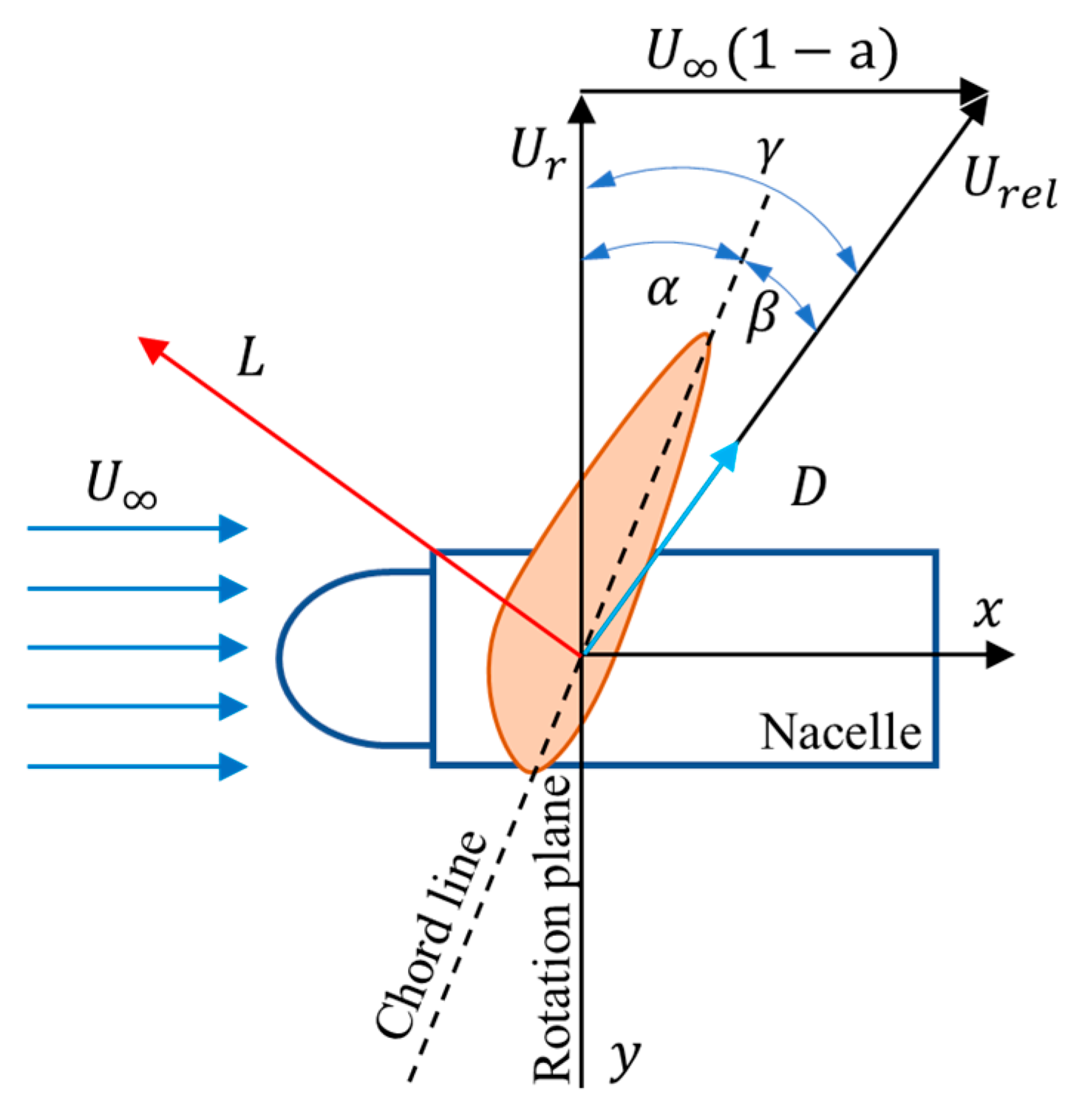
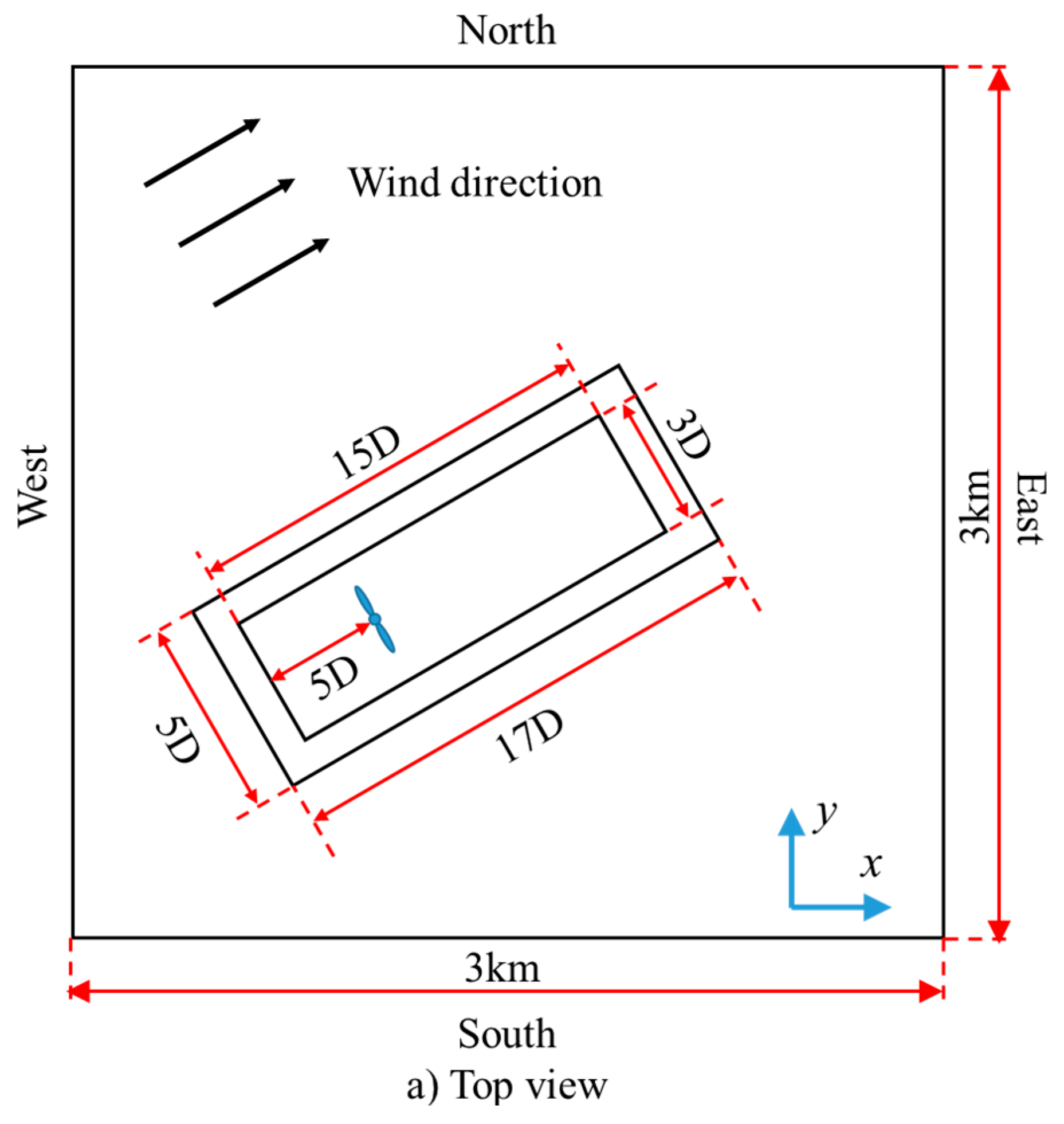
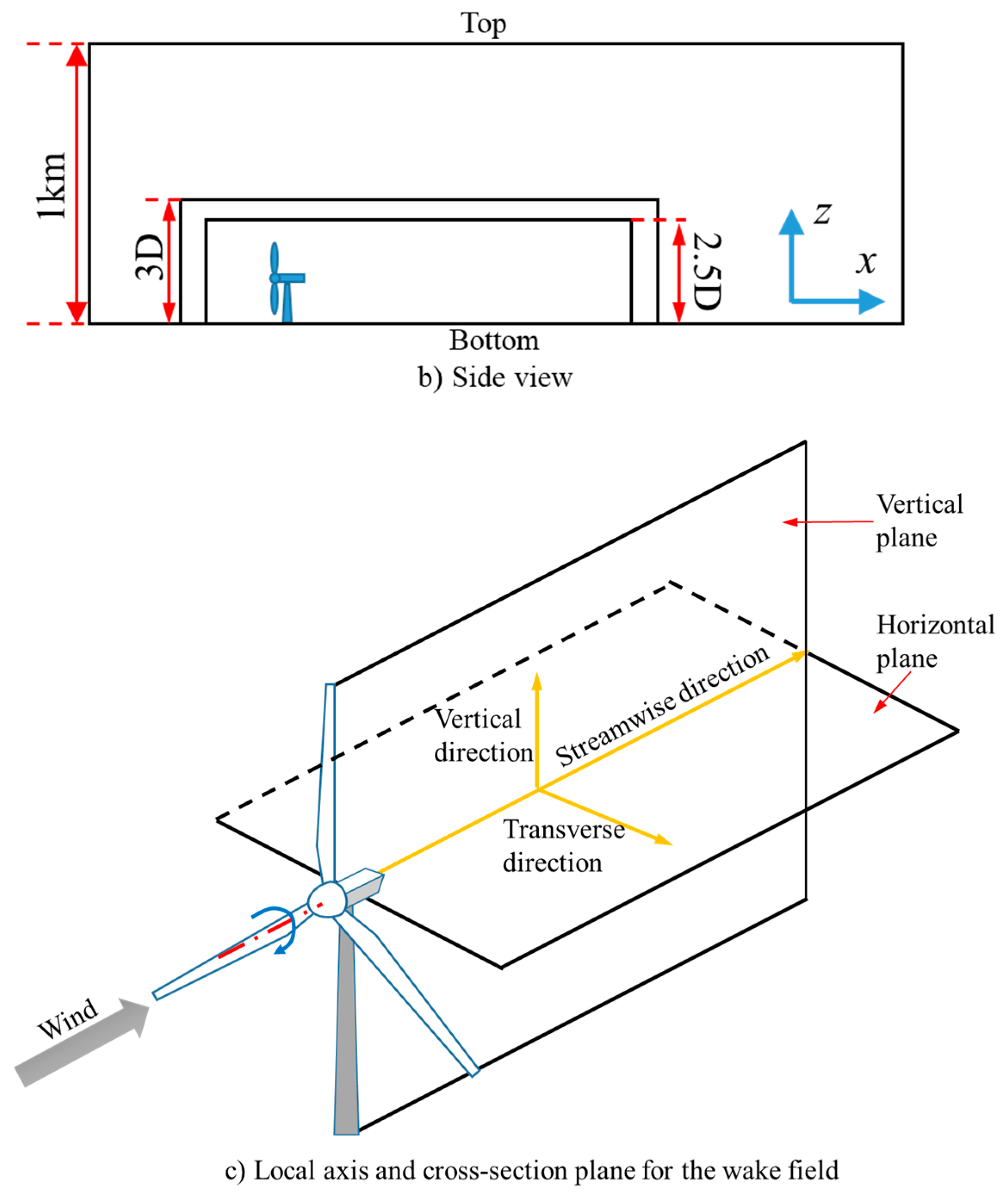


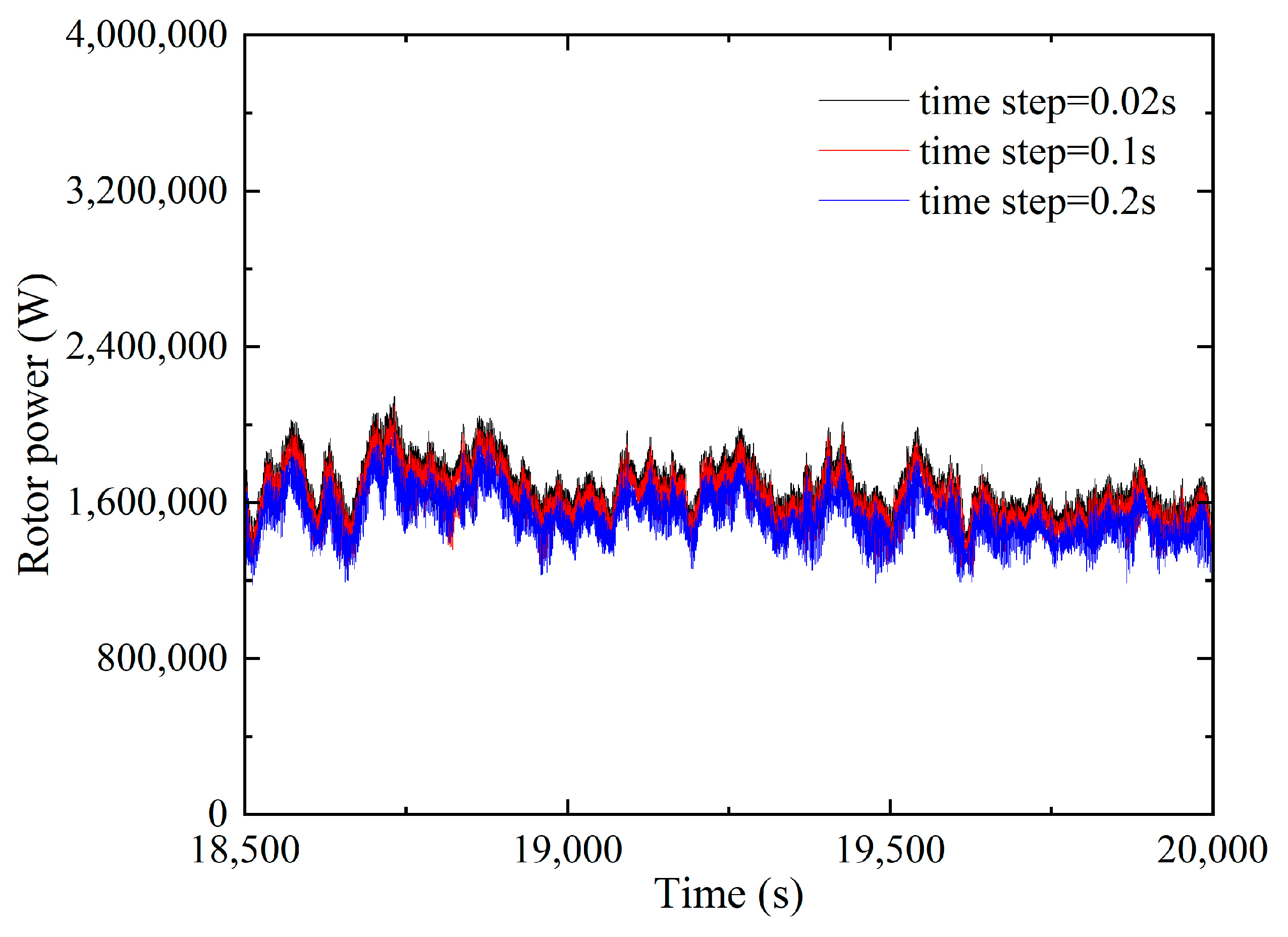
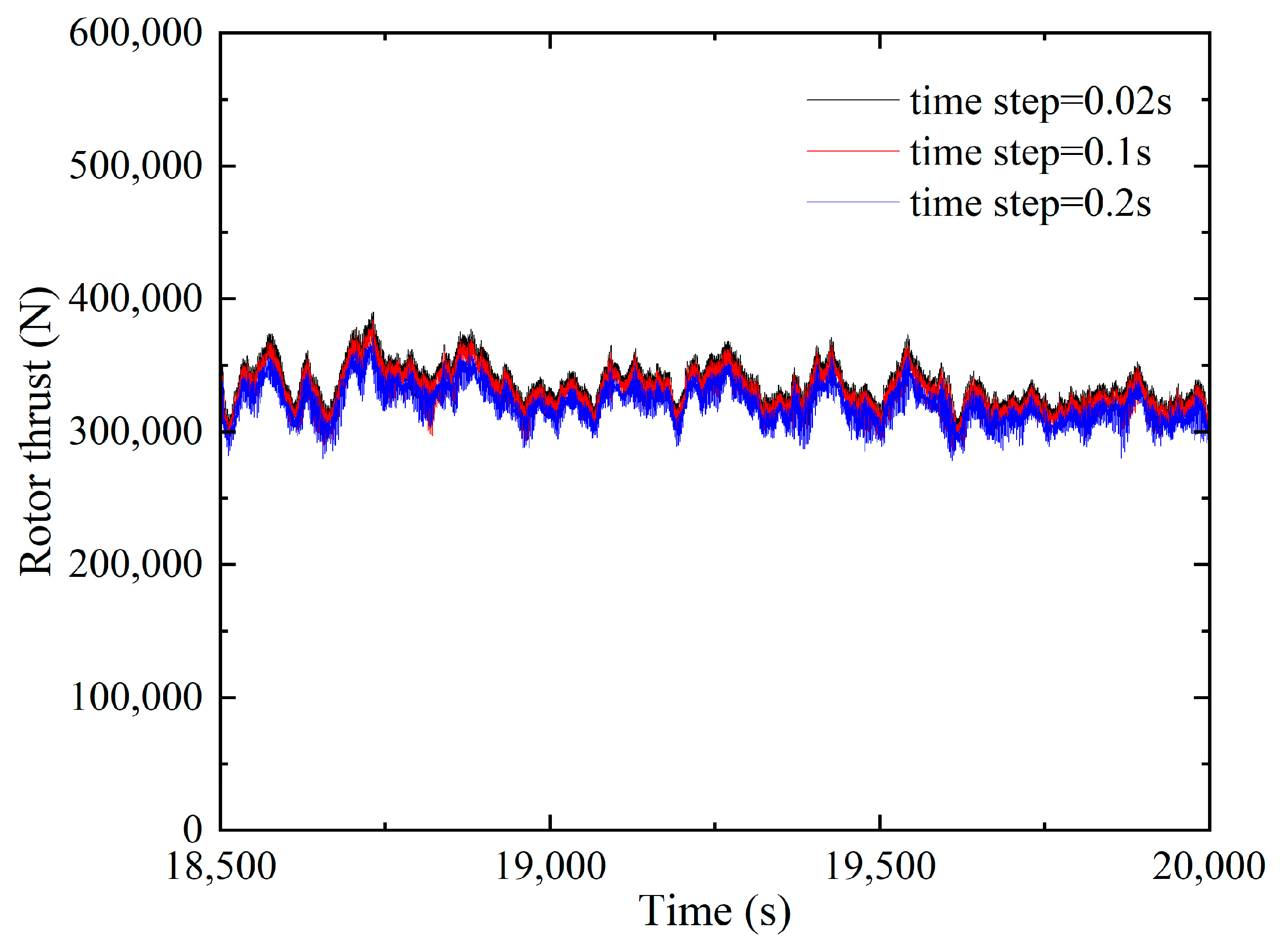
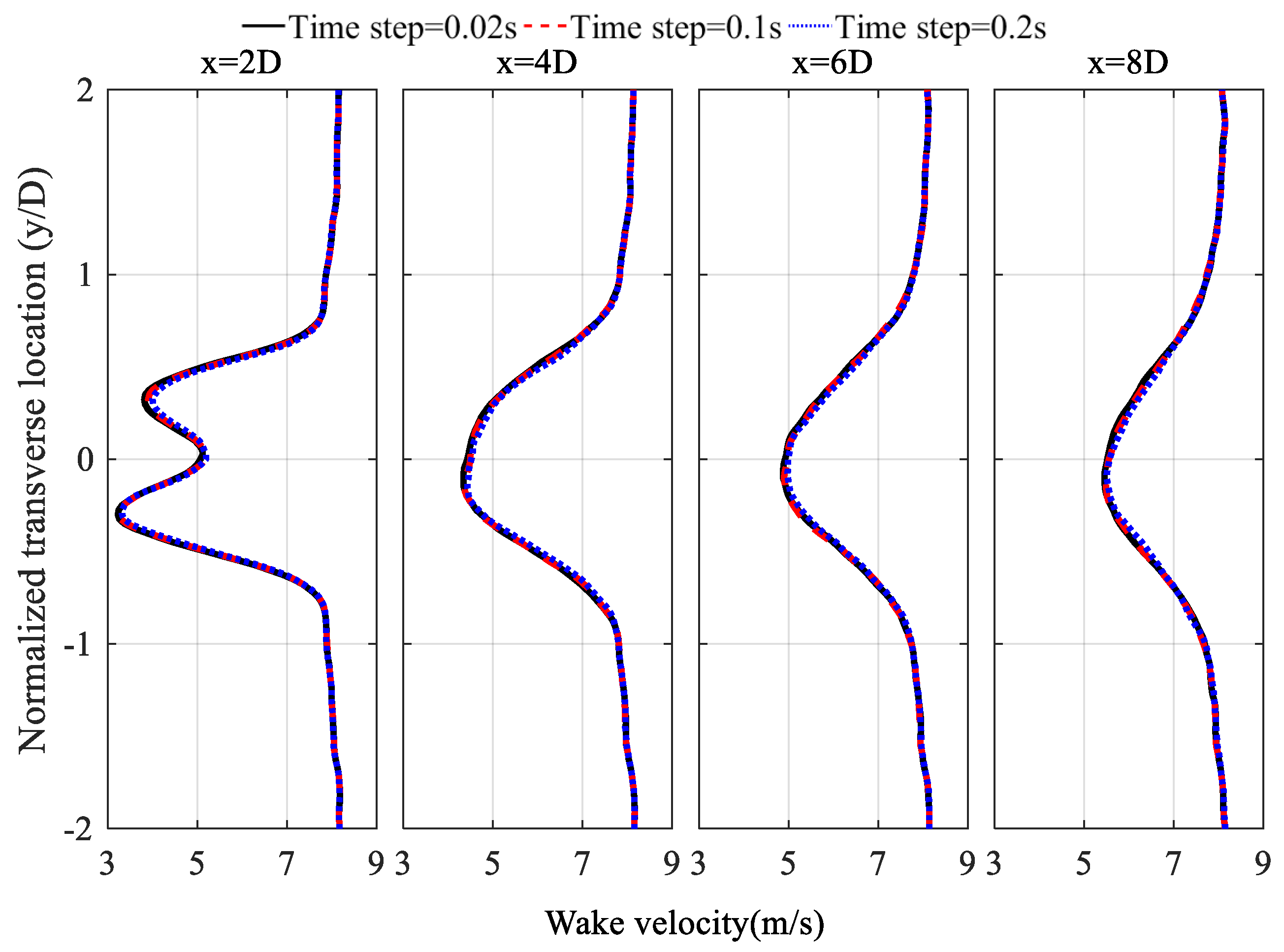
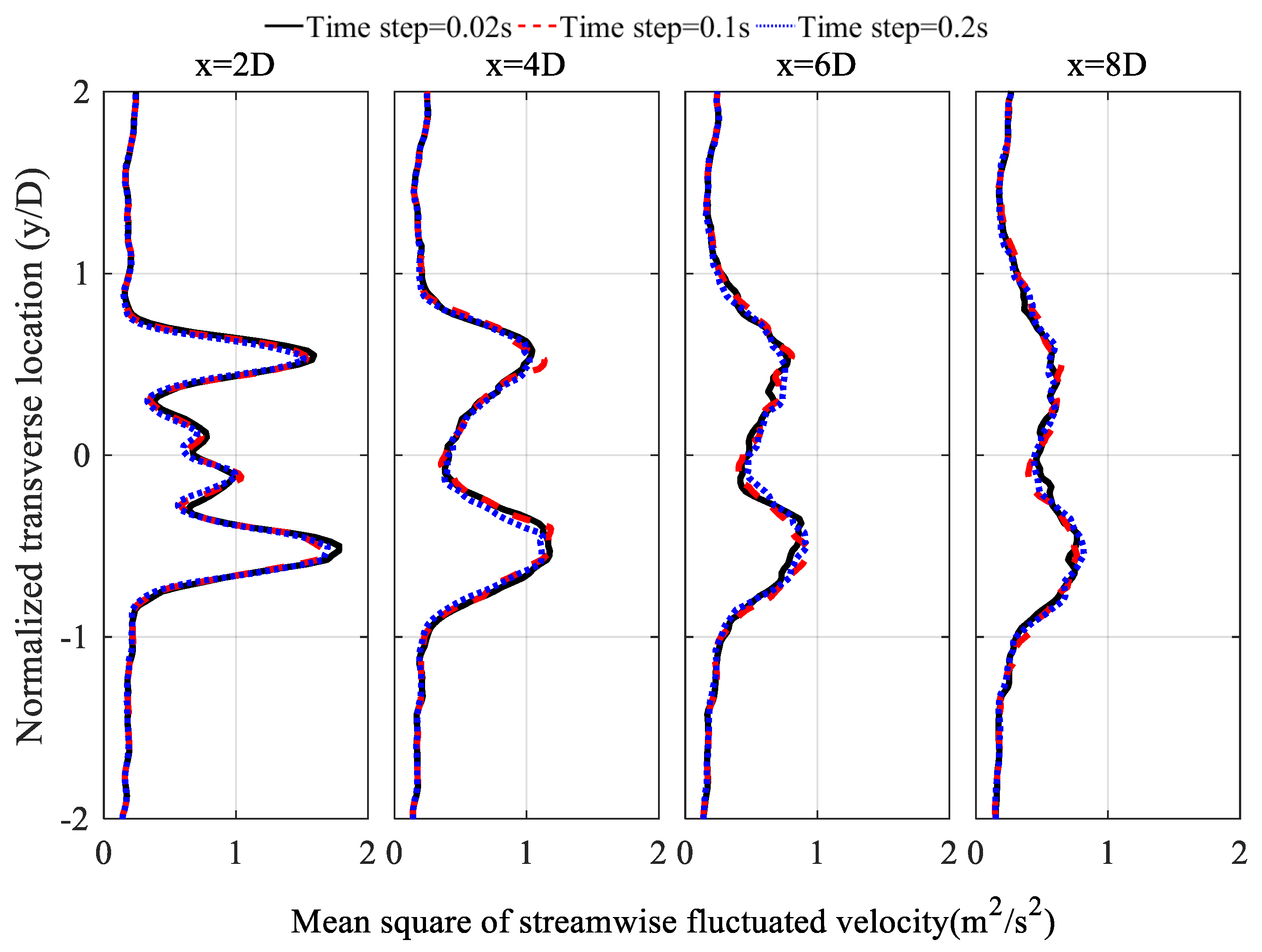
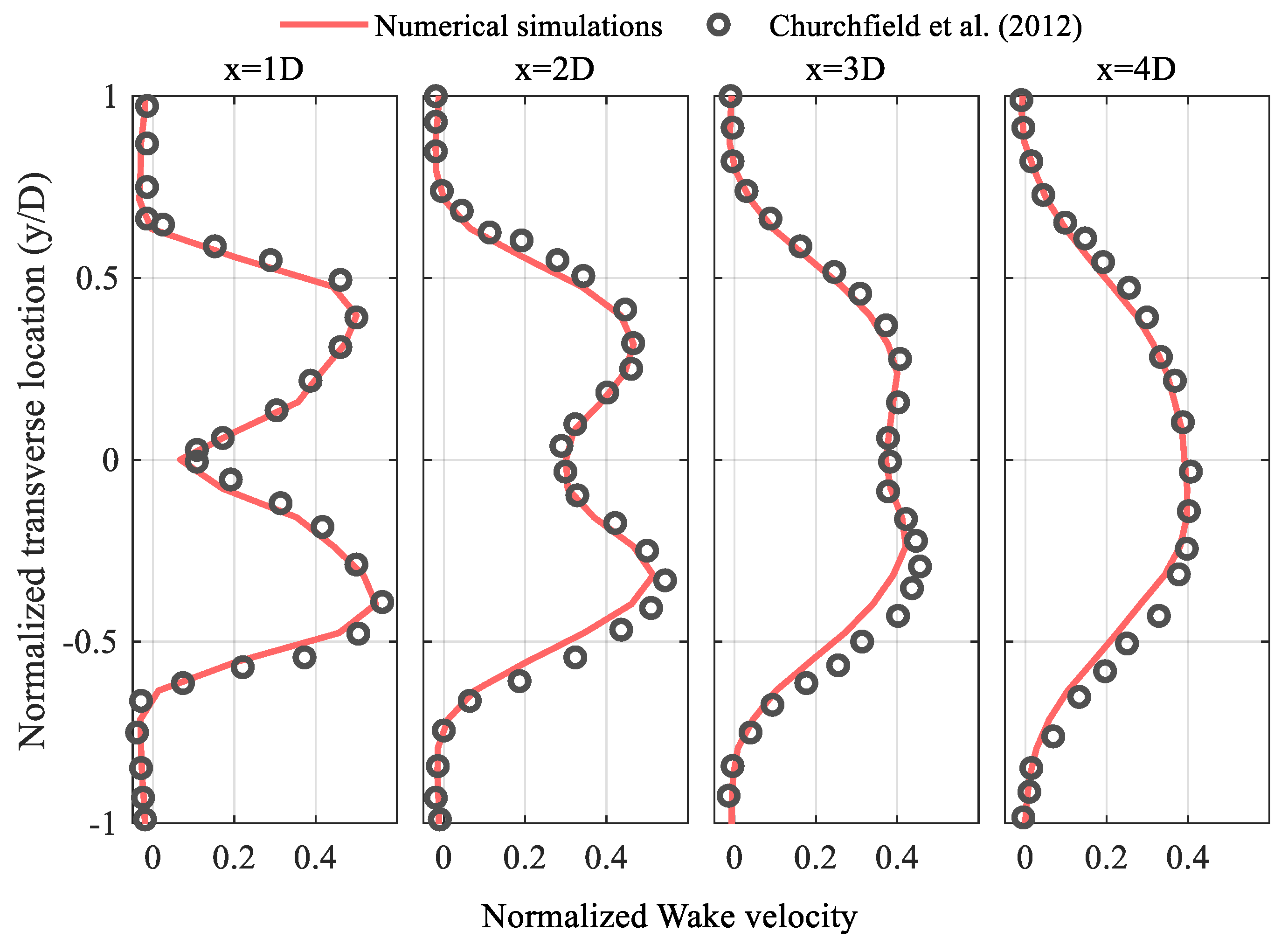

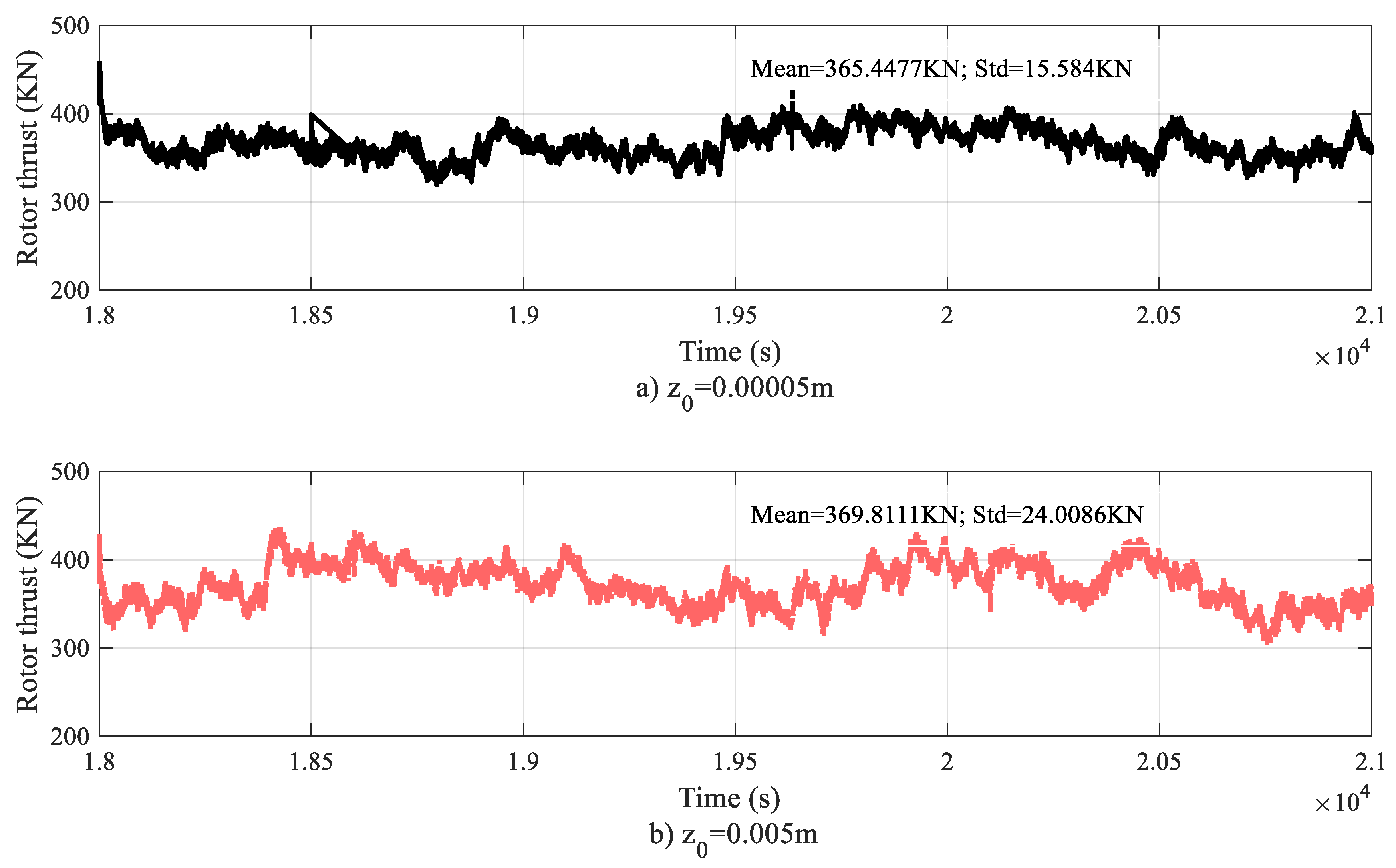


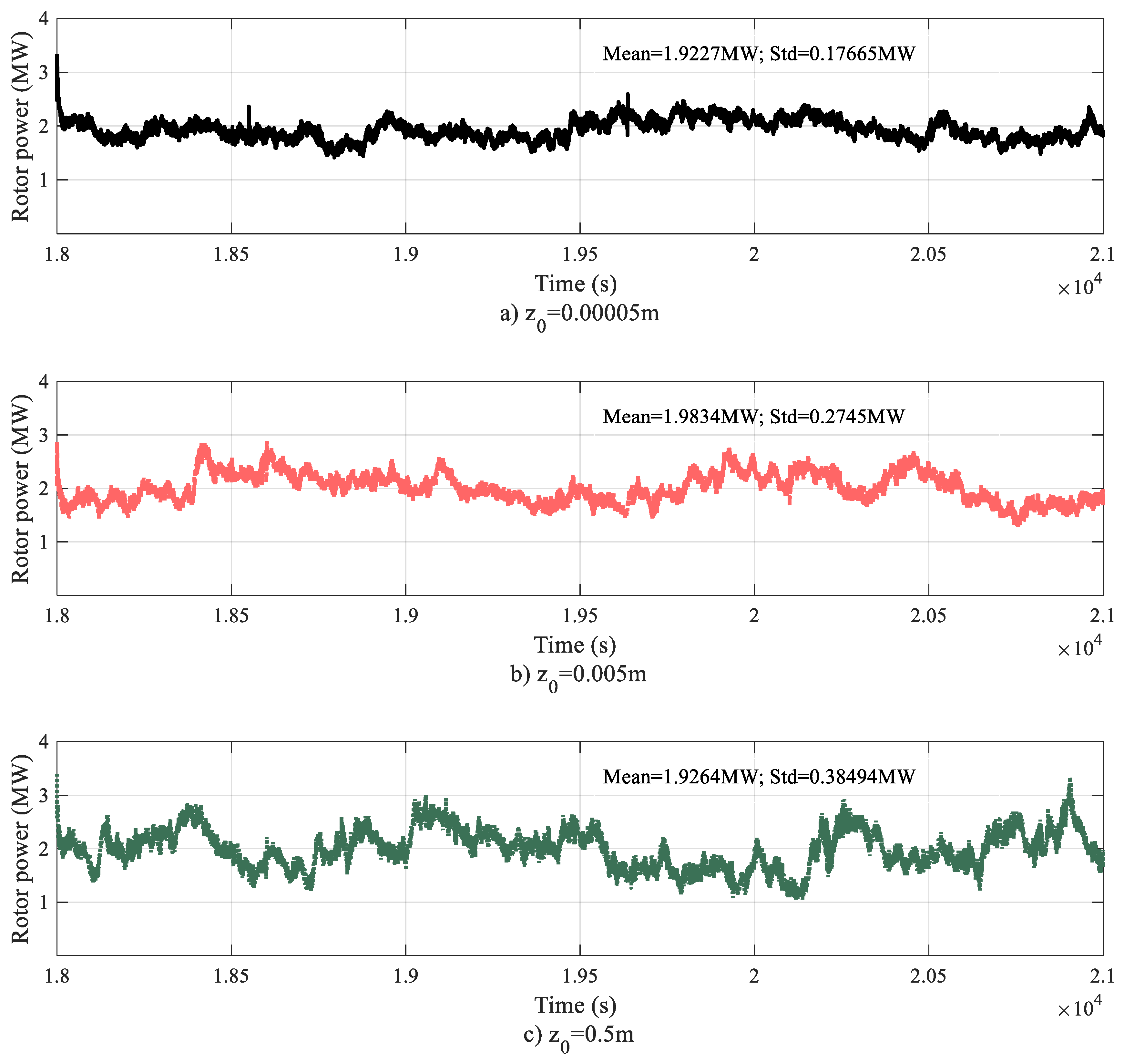
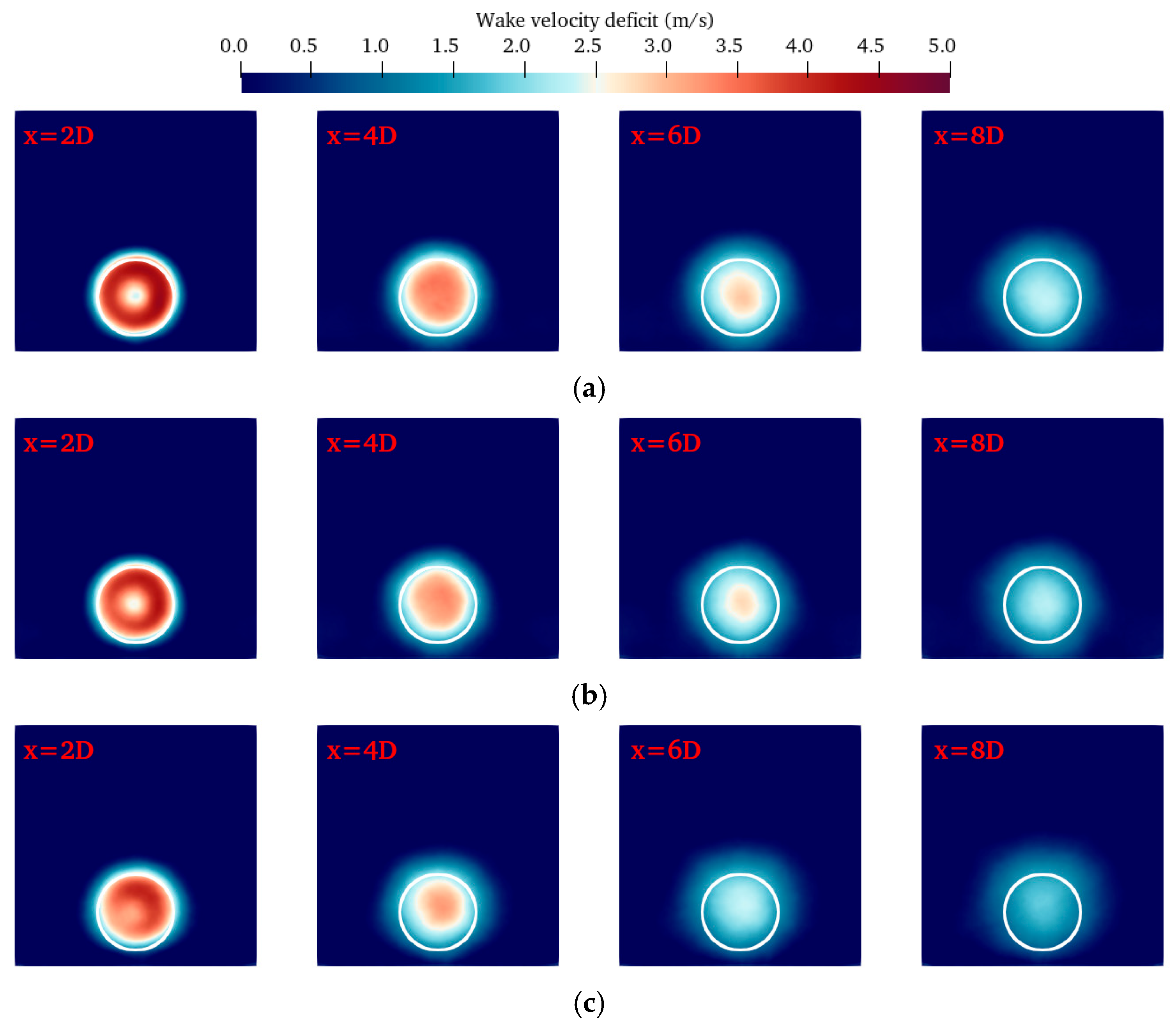


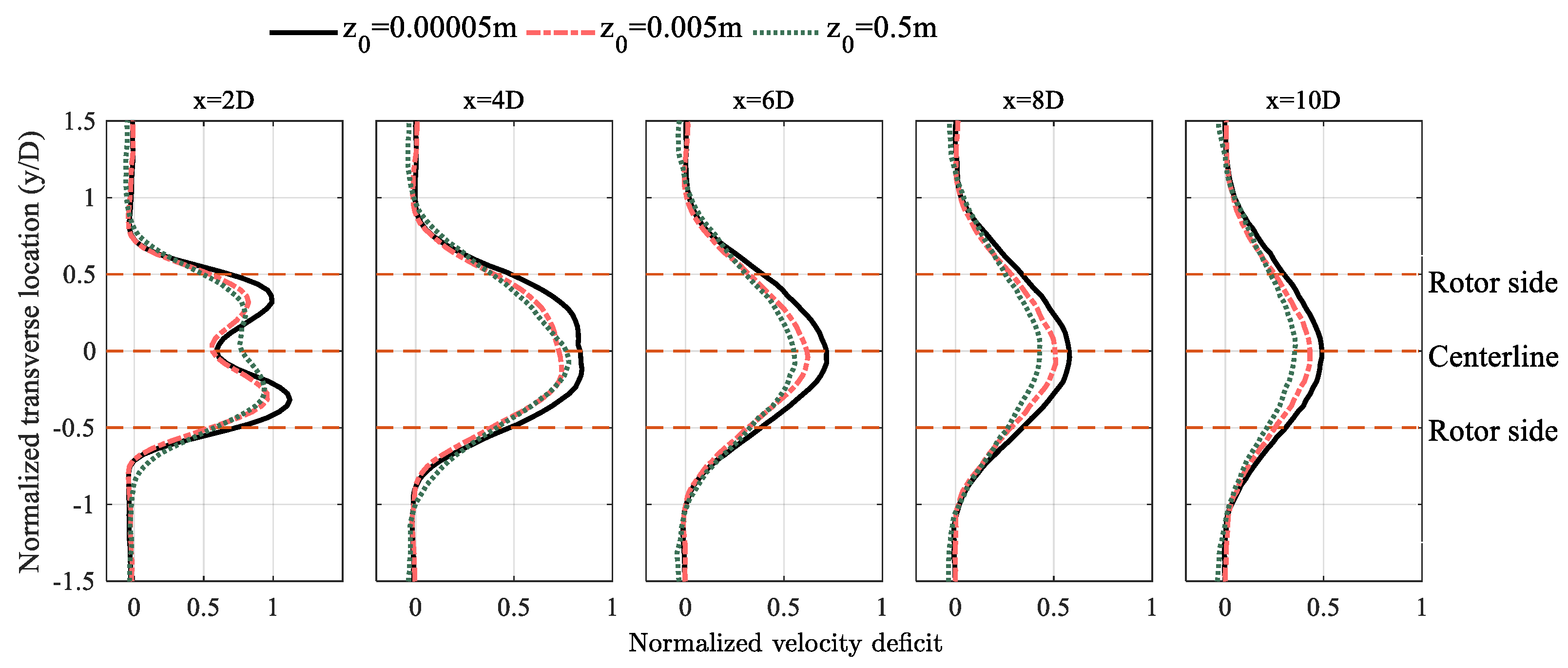

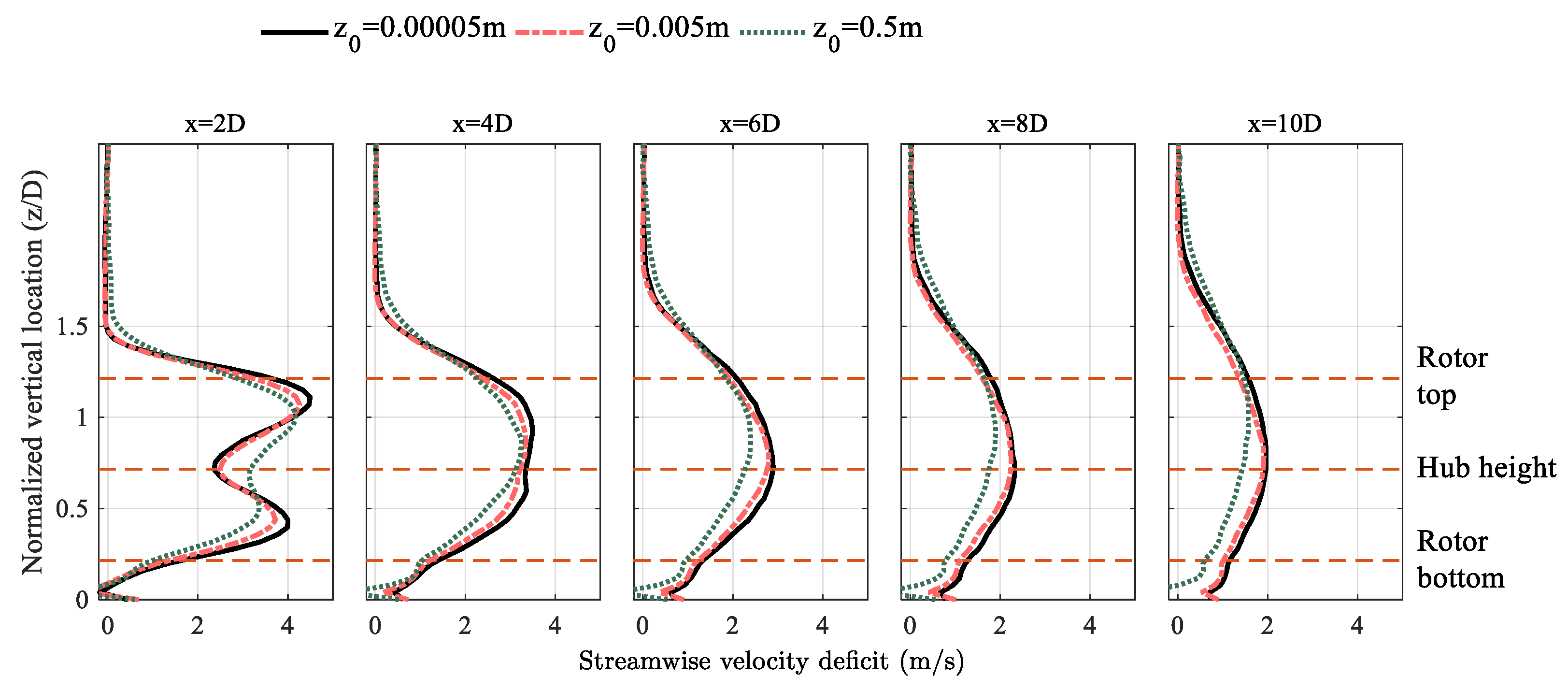
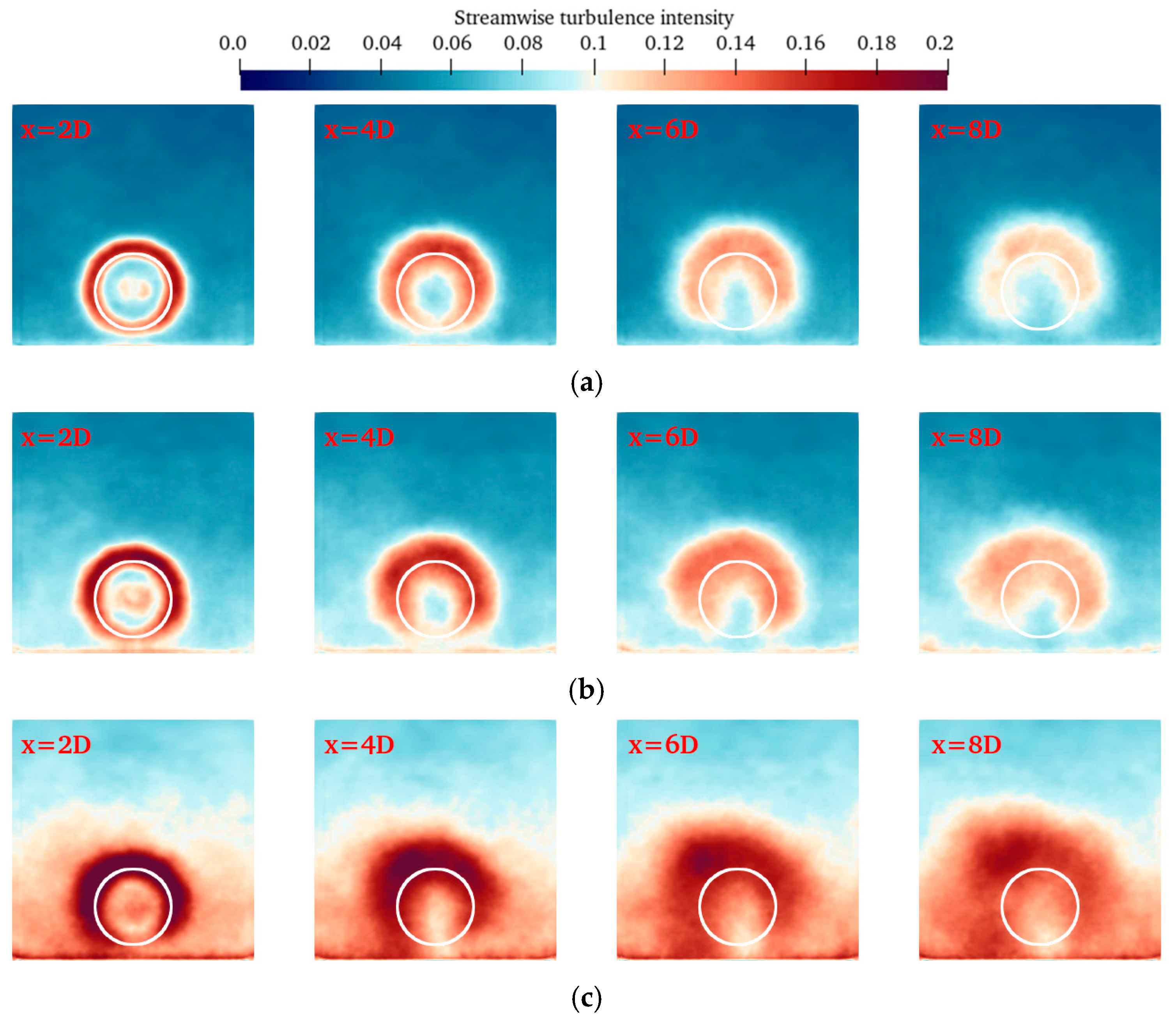

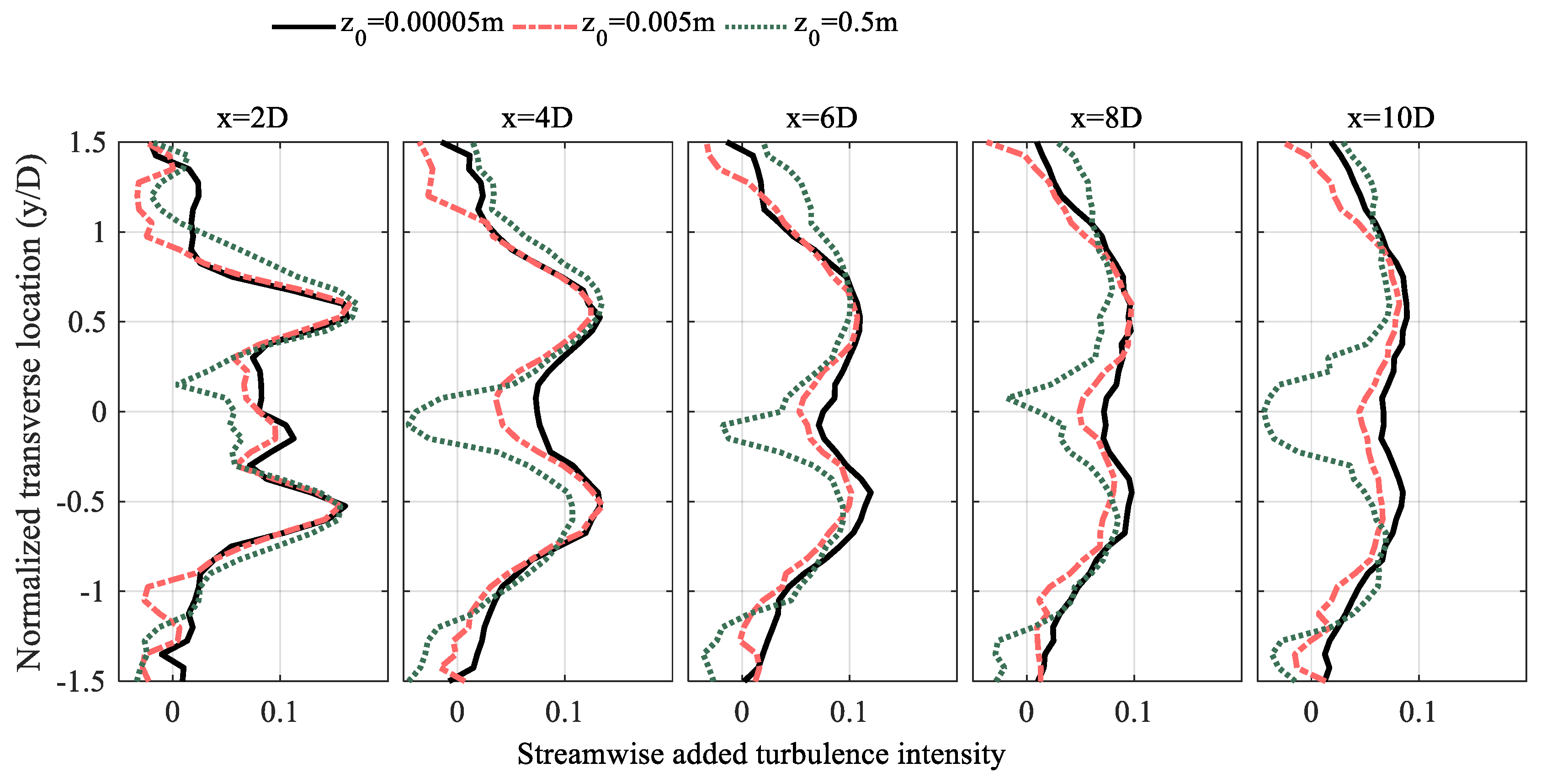


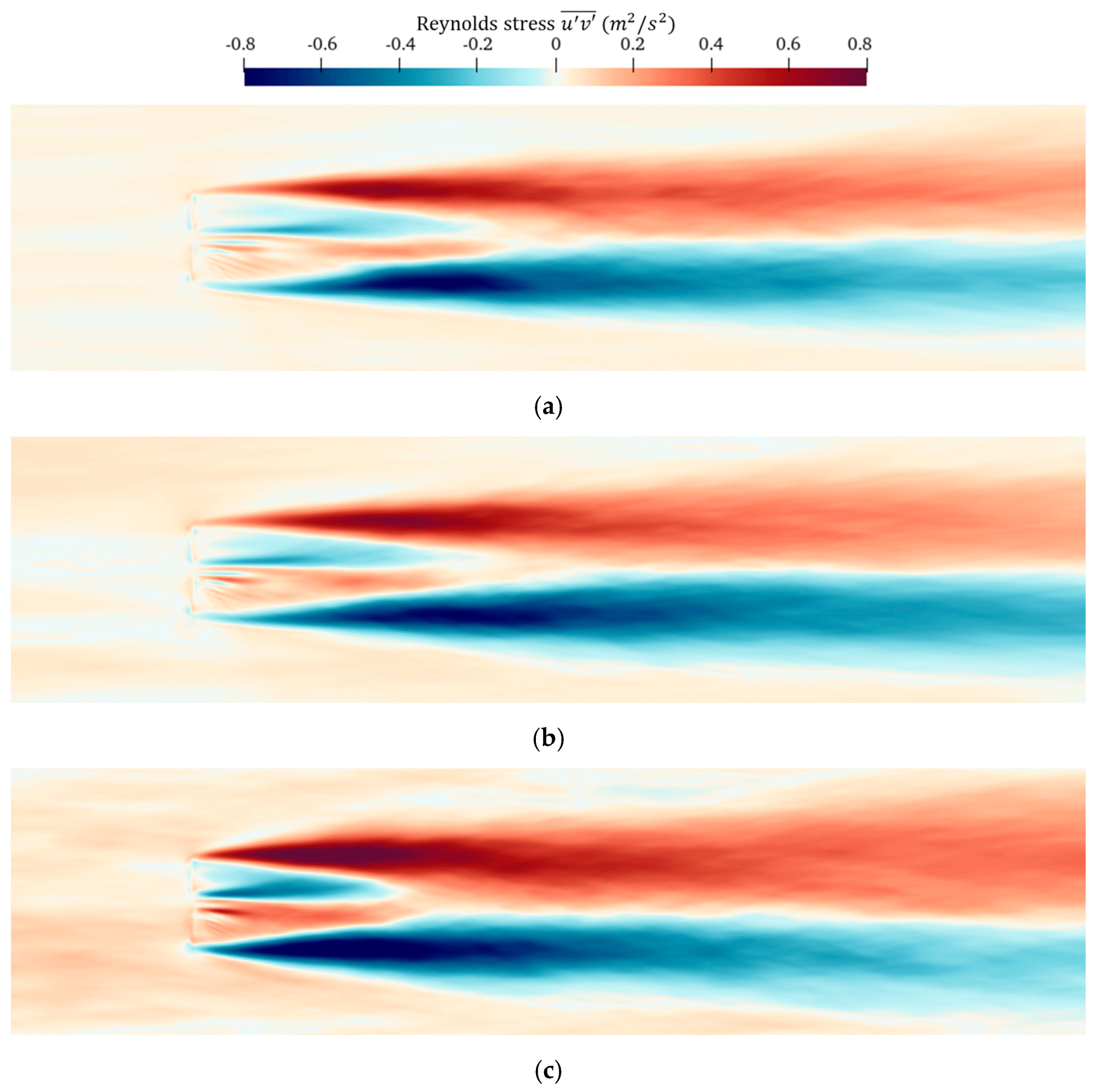

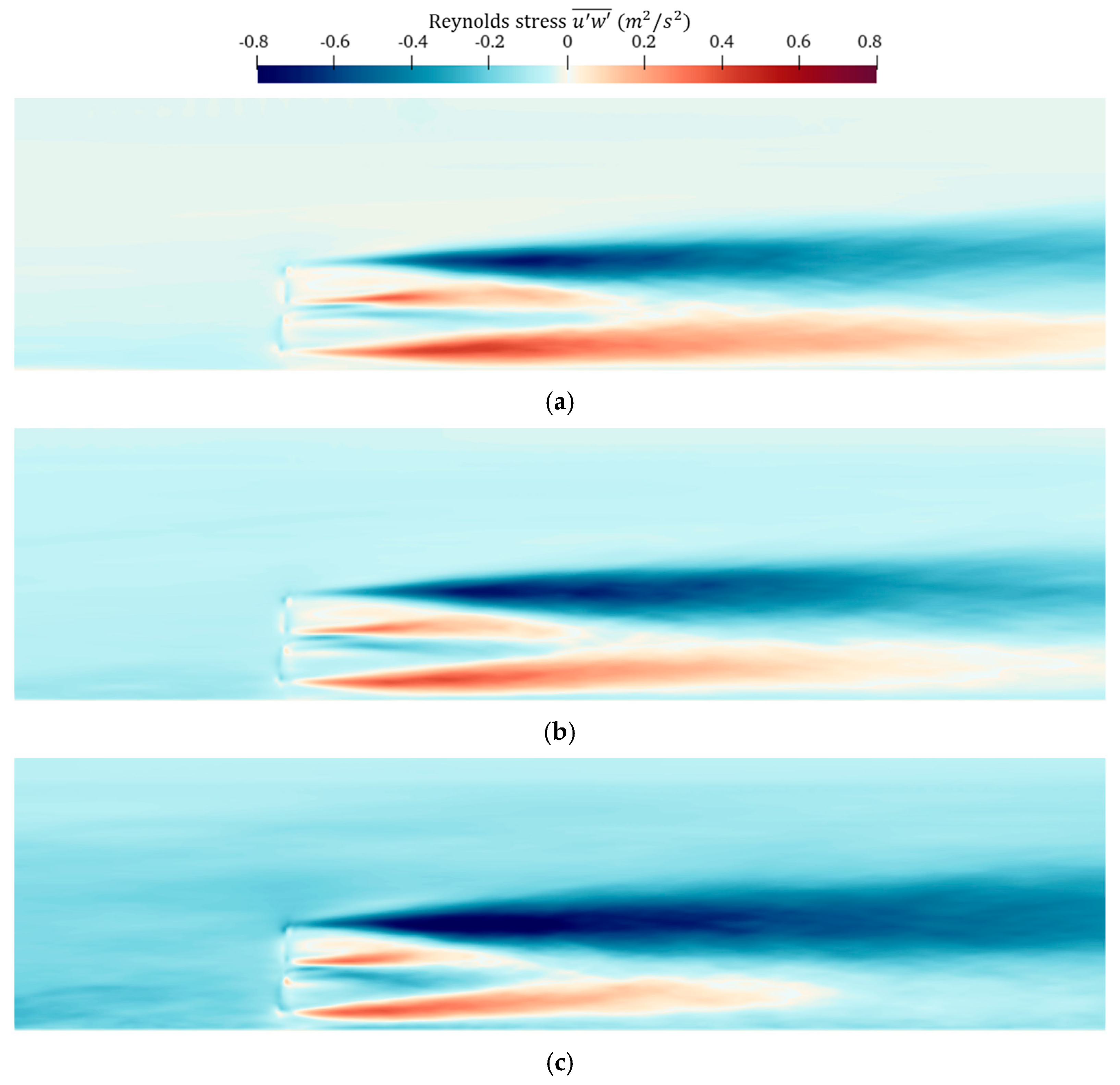

| Roughness Lengths z0 (m) | Roughness Category |
|---|---|
| 0.00005 | Calm sea |
| 0.005 | Short grasses (3 cm) |
| 0.5 | Long grass (60 cm), Crop |
| Parameter Name | Parameter Values |
|---|---|
| Number of blades | 3 |
| Hub height | 90 m |
| Diameter of wind rotor | 126 m |
| Diameter of hub | 3 m |
| Length of nacelle | 6 m |
| Rotor tile angle | 5° |
| Rotor cone angle | 2.5° |
| Time Step (s) | Mean Power (W) | Relative Error |
|---|---|---|
| 0.02 | 1,659,823.50 | 0% |
| 0.1 | 1,612,428.92 | 2.9% |
| 0.2 | 1,534,145.78 | 7.6% |
| Time Step (s) | Mean Thrust (N) | Relative Error |
|---|---|---|
| 0.02 | 334,015.21 | 0% |
| 0.1 | 329,200.93 | 1.4% |
| 0.2 | 321,092.86 | 3.9% |
| Churchfield et al. [15] | Present Simulations | Relative Error | |
|---|---|---|---|
| (%) | 5.9 | 5.8 | 1.7% |
| (%) | 4.9 | 5.0 | 2% |
| (%) | 4.4 | 4.6 | 4.5% |
Disclaimer/Publisher’s Note: The statements, opinions and data contained in all publications are solely those of the individual author(s) and contributor(s) and not of MDPI and/or the editor(s). MDPI and/or the editor(s) disclaim responsibility for any injury to people or property resulting from any ideas, methods, instructions or products referred to in the content. |
© 2024 by the authors. Licensee MDPI, Basel, Switzerland. This article is an open access article distributed under the terms and conditions of the Creative Commons Attribution (CC BY) license (https://creativecommons.org/licenses/by/4.0/).
Share and Cite
Liu, G.; Yang, Q. A LES-ALM Study for the Turbulence Characteristics of Wind Turbine Wake Under Different Roughness Lengths. J. Mar. Sci. Eng. 2024, 12, 2213. https://doi.org/10.3390/jmse12122213
Liu G, Yang Q. A LES-ALM Study for the Turbulence Characteristics of Wind Turbine Wake Under Different Roughness Lengths. Journal of Marine Science and Engineering. 2024; 12(12):2213. https://doi.org/10.3390/jmse12122213
Chicago/Turabian StyleLiu, Guangyi, and Qingshan Yang. 2024. "A LES-ALM Study for the Turbulence Characteristics of Wind Turbine Wake Under Different Roughness Lengths" Journal of Marine Science and Engineering 12, no. 12: 2213. https://doi.org/10.3390/jmse12122213
APA StyleLiu, G., & Yang, Q. (2024). A LES-ALM Study for the Turbulence Characteristics of Wind Turbine Wake Under Different Roughness Lengths. Journal of Marine Science and Engineering, 12(12), 2213. https://doi.org/10.3390/jmse12122213






